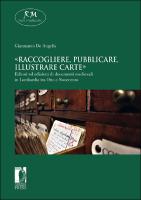«Raccogliere, pubblicare, illustrare carte». Editori ed edizioni di documenti medievali in Lombardia tra Otto e Novecento
Abstract
A long eighteenth century - on the footsteps of the erudite tradition and of the Muratori’s publishing method - and a very short nineteenth century, enclosed between the first post-unification decade and the threshold of the Great War, when the advent of a new and professionalised generation of scholars (Bonelli, Vittani, Torelli, Manaresi) would also impose a radical change in Lombardy in the field of palaeographic-diplomatic research. These are the coordinates (of a conceptual rather than a chronological nature) of the book, which for the first time analyses a significant period of medieval history under a historiographic perspective and retraces the careers, projects, the initiatives of the individuals and institutions that have animated that epoch. The editors and the editions of medieval documents coming from Lombardy are at the heart of the publication, although wider perspectives and many protagonists whose fame goes beyond the borders of regional culture revolve around them. The process of defining a modern diplomatic philology in the editions of Lombard sources is followed, marking its salient stages and turning points. However, in the background stand out the broader (as well as stronger and ideologically connoted) themes of Medieval studies before and after the Unification of Italy. These are the issue of the Longobards, the myth of the Commune civilisation in the Risorgimento culture, the identity of the Visconti-Sforza state. Analysing the editors and the editions of medieval documents in Lombardy between the nineteenth and twentieth century means shedding a significant light on the very dynamics of the organisation of regional historical research. Such analysis moves within a lively debate offering scientific and cultural implications between the hegemonic Milanese centre and the sometimes riotous municipalisms of the many suburbs.


 Download
Download Web Shop
Web Shop